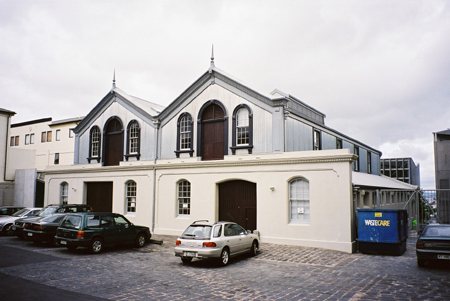This building is a well-preserved example of New Zealand industrial architecture, and a reminder of the role of horse transport in nineteenth- and early twentieth-century Auckland. Located in a fashionable colonial suburb, the two-storeyed building is a remnant of a much larger stabling complex, owned and developed by W. & G. Winstone from 1882-1883. The Winstones were coal merchants and general carriers, who profited from haulage contracts issued by the 1870s Vogel government. The firm expanded into stone extraction and other businesses, constructing the stables close to basalt quarries in the Newton and Mt Eden area. The company was one of the largest haulage firms in the Auckland region, and had at least 250 horses on the road by the 1920s. Draught animals were gradually replaced by motor vehicles, particularly between the First and Second World Wars, and by 1949 Winstone's had only three horses in service. Designed by Robert Watt, the stables building was at the forefront of local technology when erected in 1883. Early mass concrete was used for the ground floor of the structure, where there were stalls for at least 30 Clydesdale horses and an elaborate drainage system for the disposal of waste. Its upper level was of timber-framed construction with corrugated iron cladding, and was employed for storing horse feed, equipment and items from Winstone's furniture-removal business. The building was conceived from the outset as part of a larger complex, with workers' housing to the rear. The Italianate style of the structure's main facade mirrored that of William Winstone's house, which was also located within the complex, fronting Symonds Street. Changes were made to the stables as the company expanded, with extensions being added in about 1885 and 1896. A major fire in 1897 caused damage to the interior, although all of the horses were saved. In 1929 Winstone's leased part of the structure to Claude Neon Lights, producers of the first neon lights in the country, following their investment in motorised transport. Subsequently used as a food factory and artists' quarters, the building was saved from possible demolition after a public campaign in the late 1990s and conserved, with the loss of some of its additions, for commercial use. The building is significant as one of the earliest known concrete buildings for industrial use in Auckland. It is an unusually ornate example of industrial vernacular architecture from the later colonial period, reflecting the prosperity of some companies in the road haulage industry. It is of value for illustrating the everyday role of horse transport in late nineteenth- and early-twentieth century urban life, and provides important information about animal welfare, sanitation and working conditions for employees. The building is significant as one of the only major remnants of a much larger working complex, whose layout reflected the close nineteenth-century relationship between the workplace and the home. The structure provides evidence of later industrial activity, including neon light and confectionery manufacture. It is significant for its links with prominent companies such as Winstone's and Claude Neon Lights. The building is held in high public esteem, and illustrates the light industrial history of the Newton area of Auckland, which is rapidly disappearing. Other industrial structures nearby include the Colonial Ammunition Company Shot Tower in Mt Eden.

Location
List Entry Information
Overview
Detailed List Entry
Status
Listed
List Entry Status
Historic Place Category 1
Access
Private/No Public Access
List Number
7425
Date Entered
6th June 1998
Date of Effect
6th June 1998
City/District Council
Auckland Council
Region
Auckland Council
Legal description
part of Lot 1 DP 32276 & Lot 1 DP 42851 pt Allot 3 Sec 7, Suburbs of Auckland
Related listings
Stay up to date with Heritage this month
